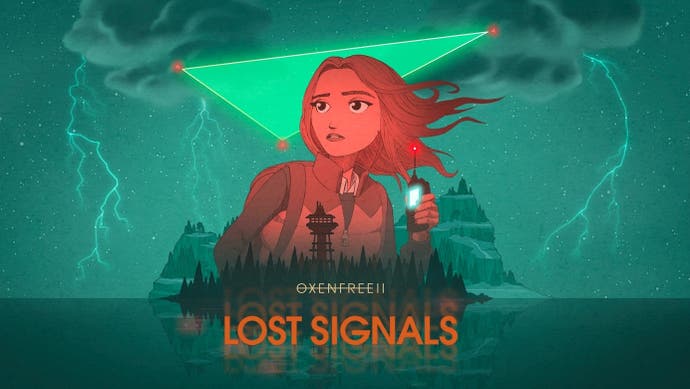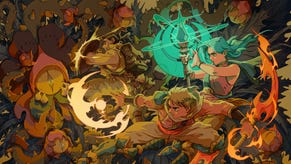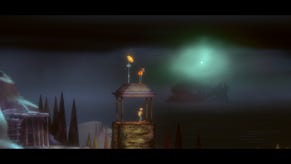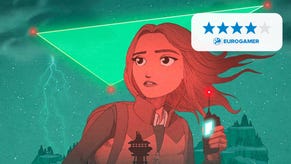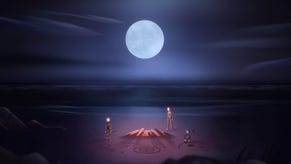Oxenfree 2: Lost Signals promises that same delicious spookiness
Hey! Can't find nothin' on the radio.
Here's something. One word stories. One-word stories? One Word Stories! Anyway, Jacob has been walking through the darkness for quite a while and it's starting to get to him. The mood starts to get to him, the atmosphere, oppressive and enclosing. So he suggests to his friend Riley: let's play one-word stories? Each of us says a word in turn, and then the words make the story.
They play for one round - a silly kind of sentence emerges - and it makes him feel better. And this gets at the heart of Oxenfree 2 for me, I think. On one hand, there's that dizzying complexity going on behind the scenes, because as Jacob's friend Riley, you get to choose which word to say, which in turn must impact which word Jacob then chooses as a response. I close my eyes at that and see the decision tree branching out, its bright leaves filling the space above my head. What a thing! A marvel.
And then on the other hand - what a lovely bit of observation. Someone who is self-aware enough to know that a game is what they need to calm them down, to orient them. A game which - I asked - is inevitably plucked from a developer's own experiences, so the plaiting of life and fiction continues.
I had been waiting for the one-word stories moment or something like it through a half-hour hands-off demo for Oxenfree 2: Lost Signals conducted rather beautifully over Discord last week. I say beautifully, because that itself was a surprise. I can be hands-off with an RPG or a platformer, but there is a delicious torture to being hands off with a narrative game like Oxenfree, because what you do in Oxenfree more than anything is decide what the people you control are going to say at any time, picking between two or three bubblebum choices that often appear with a wonderfully wriggling impertenence while the people around you are still saying things themselves.
It's hard to sit that out. But the people demoing the game really know their Oxenfree, which is hardly surprising because they made the first game and are making the sequel. They picked well. The conversation flowed, as they say, and even the stilted moments were eloquent in that Oxenfree way: speaking to the experience of feeling your way around people you don't know as well as you think you do. A success! But even so, I wanted the moment that took me across the barrier from being impressed by what a clever game this is, to feeling - feeling what an emotionally acute and insightful game it is too. And that was one-word stories.
Fittingly, I'm probably approaching all this out of sequence. The original Oxenfree is an evocative shaggy ghost story about a bunch of teens exploring a spooky island at night. It's a Midsummer Night's Dream through a glass darkly - a Midsummer Night's Nightmare, I guess. The normal world is suspended and hierarchies are upended, but I'm pretty sure nobody trots off to marriage once it's all done. Instead, a group of misfits stumbled upon some weird paranormal BS - odd radio signals, funny rips in the fabric of reality. Two dimensions - at least two - colliding in sinister ways on a deserted chunk of rock surrounded by dark waters.
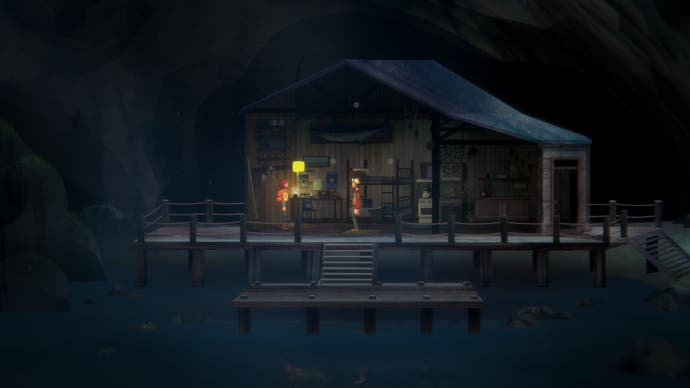
And now we get Oxenfree 2, which is an expanded and wonderfully doomy sort of sequel. Will you need to have played the original game to enjoy this? Not at all. But the story exists on the same continuum. And it has the same spirit, a vital word for this kind of experience. All of which means exploration is back. The spooky radio you can tune in as you wander around in the dark is back. The same plot threads lie about, tempting you to knot them together. Another world - at least one other - intrudes again. Well played!
What's different? There's a new cast, focusing on Riley and Jacob. Crucially, they're older than the teens in the first game. Riley is an environmental researcher who has come back home to investigate mysterious radio signals that are affecting the small town where she grew up, causing electrical disturbances and generally distributing the heebee-jeebees. Jacon is an old acquaintance from high school. They may not be teens anymore, but they're both clearly at crossroads in their lives. The perfect point for things to get spooky.
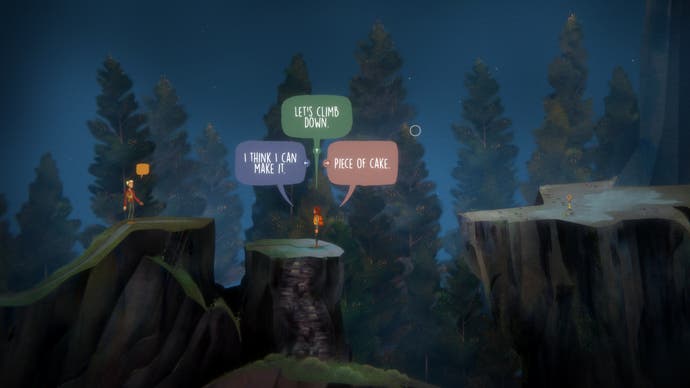
And there's a new setting - Camena, a coastal town located not far from Edwards Island, the setting of the first game. This being a sequel, it's a larger place - a quick glimpse of the map is intoxicating - and it's more intricate. This is the town where Riley and Jacob will take on a group of masked strangers called the Parentage, who are messing up all the radio and electrical jazz to open a portal between dimensions on purpose.
I got to see a glimpse of the game from about an hour into the campaign. Things are already looking bad. Riley and Jacob have made themselves visible to the Parentage somehow, and now they've broken into a store to get the climbing gear that will allow them to navigate a cave system that lies between them and a goal which I'm ashamed to say I neglected to write down. Anyway! They're soon exploring classic Oxenfree territory, wandering through the spooky night in the coastal wilderness, with lots of time to chit-chat.
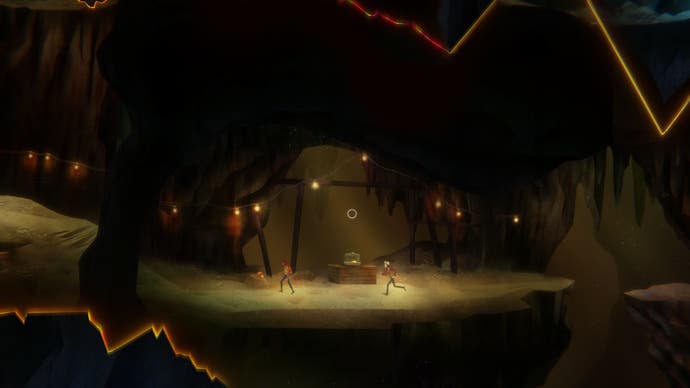
Alongside talking between themselves - and choosing how to get from A to B, each path offering its own unique distractions - the duo have a walkie talkie, a new addition to Oxenfree and a biggy. Throughout the game, you'll now receive calls from people who live in town and you can choose whether to answer them or not. And not just people in town: the first call we get is from a sinister type who claims to know us, but won't tell us who they are. "You know who this is, but I'll give you space to figure it out for yourself," they say, before telling us an unsettling fable and logging off.
Gah! Thankfully, shortly after that we get a call from a Camena resident who asks us to check his backpack is safe over at a fisherman's outpost that lies nearby. Plenty of townfolk will be in touch over the course of the game, and many of them, like this one, will do us favours if we help them out with something. Backpack guy turns out to be a retired amateur explorer, who promises to give us more information about the area if we need it. That will come in handy, for sure, but I also think there's just a bit of evocative flair in the idea of meeting this proud old gent over the airways, a fellow who signs off by saying that he'll be up all night anyway so he'll be free to chat when needed. A little cameo portrait emerges in a moment like that.
The walkie talkie, with its calls from residents that can open up side quests but can also be ignored, gives Oxenfree 2 a sense of a slightly wider world. A world that moves in real-time as the player does. Opportunity is created, but opportunity cost is also invoked. Very Oxenfree.
This sense of continuity is palpable throughout the demo. Every decision made once again affects how the story turns out, and Oxenfree continues to be wonderfully light-touch about this stuff. Wandering through the caves, Riley and Jacob aren't really talking about their main mission that much. They're learning about each other again, two acquaintances who fell out of touch and are now thrown back together. This means that Jacob is learning about the player through the decisions the player makes in how to respond and what to reveal, all while they pick a path through a complex space: there's a lovely promise of intricacy here.

And drama, of course. Towards the end of the demo, the duo discovers a time tear - a new kind of challenge formed by a natural fissure in the space-time continuum. Aren't those things the worst? It allows Riley and Jacob to open up a passage to a different time period in the same area, and in this case it allows them to navigate a blockage in the present by ducking back into the past when the mines are still in use.
There's a puzzle waiting for them, involving a rickety elevator. And of course the whole thing ends with a bit of life-and-death drama. But what I noticed most about this final set-piece, which I really don't want to spoil that much, is how the Oxenfree team sells the arrival of Riley and Jacob in the past. Not with anything big, but with something small and precise: a smell, a sudden odour of old tobacco that tells the gang they're back in the time of people working underground in the 19th century, the time of - granted, amongst a lot of other things - pipes and funny hats and old men getting ornery with each other.
It's stuff like that which marks this series out, I think. A different kind of preoccupation, a desire to notice different sorts of details. I remember playing through the first Oxenfree and just messing around with the radio that the characters carry with them - a radio that returns here. Spinning the dial and hearing static and spooky voices, sure, but also creepy old music, proper echoes of a distant place that seemed dark yet tangible - broadcasts that definitely came from a specific somewhere else.
I guess I'm spooking myself just thinking about it. And to get that spooked from a Discord presentation is probably a pretty good sign, I reckon.
